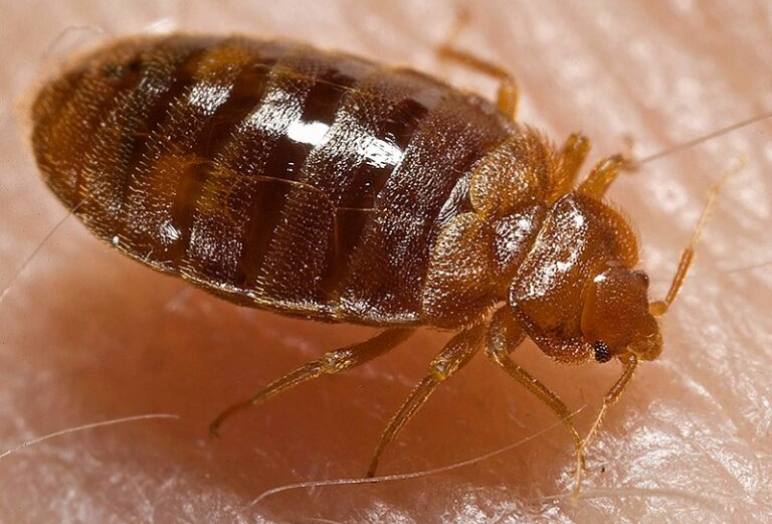
Bed Bugs Control
Bed bug control refers to the various methods and strategies used to eliminate or manage bed bug infestations. Bed bugs are parasitic insects that feed on the blood of humans and animals, usually during the night while they are sleeping. They can infest homes, hotels, dormitories, and other spaces where people reside.
Characteristics:
Two pairs of wings(but can’t fly) normally present; mouth parts piercing and sucking, forming a beak, or rostrum, normally held under the body. Metamorphosis usually incomplete, with egg and nymphal stages.
Flat, oval insects, with very short, functionless forewings; hindwings absent; rostrum lies in a ventral groove; tarsi 3-segmented; exclusively bloodsucking.
Species characteristics and host/habitat:
Common bed bug
(Cimex lectularius) Adults, 5mm long, reddish-brown in colour, becoming purple after feeding; well-developed antennae; prominent, simple eyes; feet clawed so can climb rough but not smooth Surfaces; ratio of head width (including eves) to length of third antennal segment usually greater
than 1.7.
Other blood-feeding bugs
Blood-feeding bugs, very similar in appearance to the Common bed bug can often be found infesting birds’ nests and bat roosts. In certain circumstances, these bugs may invade houses and attack humans. They include:
- Pigeon Bug (Cimex columbarius).—Very similar in size and appearance to the Common bed bug; can be distinguished by the ratio of head width to length of third antennal segment, which is less than 1.6 in most specimens.
- Martin Bug (Oeciacus hirundinis)—-Similar in appearance to the Common bed bug, but smaller and more hairy. Can be further distinguished by the following characteristics: when viewed from above, the front margin of the prothorax is far less concave than in the other species; the head width is also more than twice the length of the third antennal segment.

The Signs of Bed Bug Presence.
- Bed bugs have to be brought in
♦ Traveling
♦ Used Furniture - First indicator is unexplained itching red welts
- Bites suggest bed bugs but are not definitive
- Medical doctors are terrible about diagnosing bites!

Bites
- One study found only 30% had a reaction when bitten bya bed bug.
- Another study indicated that 96% (of refugees in Sierra Leone) had reactions.
- Reaction will vary depending on your immune system and number of bites
- More evidence is needed than bites to confirm are bugs.
Areas where found &Local Habitats
As bed bugs cannot fly, they must either crawl or be passively transported in clothing, or more probably in luggage, furniture, books and other objects used as harborages. The infestations will only become established in premises with low standards of hygiene, usually in the bedrooms. Both juveniles and adults live similar lives, hiding away in cracks and crevices.
- Hotels, Hospitals, Restaurants, Houses, Mosques …etc
- Labors Camps.
- Used Furniture Shop.
- Public Transportations system (Buses…etc).
IPM ( Integrated Pest Management ) Techniques for Bed Bugs in Residential and Commercial Settings
Inspection and monitoring as a means of early detection.
- Visual inspections must be very thorough particularly if the infestations is small
- Most small infestations a centered around the bed or sleeping area
- In a hotel, a thorough inspection of the room will typically take two people 1.5 h to complete
- A home bed room will take longer.
- Removing the bagging the bedding, to inspect the mattress (surface, seams and tag), the box etc. springs, behind the headboard, bed frame and under the bed.
- Inspect nightstands, removing drawers to look inside and inspecting all set-in screw holes etc.
- All furniture must be inspected in a systematic and logical order.
- Next inspect walls, electrical faceplates, baseboards, wall paper seams, carpet edges, moldings, and ceilings.
- If bed bugs are found they will be vacuumed, steamed or treated with a labeled insecticide.
Monitoring
- Used for detecting small infestations (early detection).
- Prevents fed bugs from leaving the area.
- Detects bed bugs that may be entering adjacent units.
- Can catch enough bed bugs to reduce the population.
Non chemicals and Chemical (lose toxicity) control for Bed Bugs.
Due to bed bug resistance, no insecticide used alone, will control a bed bug infestation. Many control methods have to be used, most of which will not be insecticides. However, insecticides are still used to get immediate kill of those bugs that can be sprayed directły. Non-toxic dusts like diatomaeous earth are used as a residual.
Culture Removal
♦ Place clothes that are on the floor into bags for dryer treatment.
♦ Remove items from under the bed. but do not move them into another room.
♦ Bag and throw away any items in closets.
♦ Old newspapers, junk mail, magazines, and broken electronic equipment should be bagged and thrown away.
♦ The pest management professional should provide specific instructions.
Vacuuming
♦ The value of vacuuming is that it makes inspections easier.
♦ In large infestations, bed bug harborages are not only filled with live bed bugs, but also with dead bed bugs, molted skins, hatched egg shells, and feces.
♦ It is often difficult to distinguish what is alive from what is dead in a messy harborage, particularly after treatment.
Steaming
Steam temperature (at the bed bug) must be 135° F (54° C) or greater.The steam head must be large. Steam power will kill bed bugs and their eggs (115° F).
Steaming is slow and labour intensive.
Freezing – CRYONITE
Bed bugs exposed to CO2, Snow at -108° F. The snow mixture is blown out a pressurized cylinder through a nozzle that forms vapors. The pressurized snow freezes the cells of the bed bug. This system will not eliminate a bed bug infestation if used alone. Other control methods will still
have to be used.
Chemical Control (consider Pesticide IPM).
Residual Spry.
Sprays are also supposed to leave behind active residues (residual) after the product has dried. Unfortunately, bed bugs are not very susceptible to dried insecticide residues. Bed bugs may have to sit on the dried residues days. If the spray is applied in cracks where the bed bugs rest, the dried residues have a much better chance of killing the bed bugs harboring there.
Dusting
Bed bugs walking on dusted surfaces will become covered in the dust. The labels for insecticidal dusts allow them to be applied in protected cracks and crevices. Dusts can be used in wall voids to intercept bed bugs travelling from one apartment unit to another. They can be puffed in behind baseboards, electrical outlets and other locations where bed bugs like to hide.
